
Hiking Dude Blog
2025 - Aug Jul
2024 2023 2022 2021 2020 2019 2018 2017 2016 2015 2014 2013 2012 2011
05/12/2017
Spring Hikes

 My morning hikes have been more adventurous and interesting for the past few weeks, for two reasons.
My morning hikes have been more adventurous and interesting for the past few weeks, for two reasons.1. My neighbor retired and has been hiking with me. Instead of just doing my normal route up and down the trail, we have branched out and are covering lots of different neighborhoods, trails, and paths. Also, our mileage has been around 6 miles rather than my old 5 miles! My SPOT track is drawing lines all over town as each day gets added to it. :-)

 2. I saw an ad on facebook for a 10x telephoto lens that you just clip onto your phone. It was something like $55 (wow!) so I looked around and found the exact same no-brand item someplace else for $8 (including shipping). The colors, markings, description 100% identical. So, I splurged and waited for it to arrive from China.
2. I saw an ad on facebook for a 10x telephoto lens that you just clip onto your phone. It was something like $55 (wow!) so I looked around and found the exact same no-brand item someplace else for $8 (including shipping). The colors, markings, description 100% identical. So, I splurged and waited for it to arrive from China. You can see here some of the photos I have taken with it. I will post about it in a couple days with more details. Anyway, it has made it more interesting trying to get some shots.
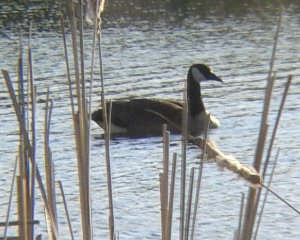
 We are fortunate to have quite a few green areas around, plus some marshes, hills, and bike paths. Lots of varied walks to take in preparation for the big trek of the summer.
We are fortunate to have quite a few green areas around, plus some marshes, hills, and bike paths. Lots of varied walks to take in preparation for the big trek of the summer. There are also lots of places for birds and animals to roam. With the mild winter, it seems we have a plethora of rabbits, squirrels, and deer. The song birds are now migrating through, or deciding to stay awhile, and I even saw a bright orange and black Oriole yesterday.

 Until the ticks get thick, and the mosquitoes start to swarm, it will be easy to enjoy the trails. It is a good time to get out there and explore!
Until the ticks get thick, and the mosquitoes start to swarm, it will be easy to enjoy the trails. It is a good time to get out there and explore!Hike On
Leave Comment
Posted: 05/12/2017
Posted: 05/12/2017
04/26/2017
SPOT Special
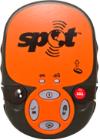
 I've been carrying a SPOT Messenger on my adventures since 2007. A SPOT is a satellite pinging device that can be used to request aid in an emergency, or just track your route. My wife is more comfortable knowing this extra bit of safety is along on each trek.
I've been carrying a SPOT Messenger on my adventures since 2007. A SPOT is a satellite pinging device that can be used to request aid in an emergency, or just track your route. My wife is more comfortable knowing this extra bit of safety is along on each trek.I use the tracking ability of the SPOT to ping a satellite about every 10 minutes. At any time during my hike, visitors here can see where I am on the trail. At the end of the trek, I have a map of my adventure and I can add geotagged pictures to my online adventure. Here's an example trek.
There is an annual fee, but here's a way you can save 20% off your service plan ...
- Purchase a SPOT device - locally at REI, Cabella's, Gander Mountain, Bass Pro Shops, EMS, Sportsman's Warehouse, or online at their web sites, or wherever you can get a good deal. It's not too difficult to find a very good deal on the device - I got mine free just before Christmas!
- Activate your SPOT device with whatever rescue and tracking options you want.
- Visit Referral Page and enter your Name and SPOT ESN to receive 20% off your next annual service plan.
By referring you, I also receive a discount on my next annual service plan, so we both win!
If you have questions about the SPOT GPS Messenger, I would be happy to answer them.
Hike On Safely
Leave Comment
Posted: 04/26/2017
Posted: 04/26/2017
03/13/2017
2017 Hike 100 on NCT
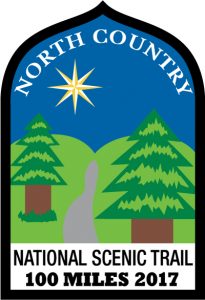
 The North Country Trail Association is at it again. These people are sneaky about tricking us into hiking more miles!
The North Country Trail Association is at it again. These people are sneaky about tricking us into hiking more miles! Anyone that hikes a total of at least 100 miles on the NCT in 2017 can get a free patch, plus they are offering prizes and free resources to folks that sign up for the challenge.
If you really get into this, there's even a Grand Prize for someone that also fulfills their Built It Challenge - that's just doing two simple activities to spread the word and get others involved in the NCT project.
They've got forms, mileage log sheets, a flyer to print and share, and other stuff to help you out. Learn all about this fun challenge and the rules at their page.
I did the challenge last year, along with about 1,500 other people, and plan to repeat this year. Anyone want to get it done all at once and thru-hike the SHT in September?
Hike On!
Leave Comment
Posted: 03/13/2017
Posted: 03/13/2017
01/26/2017
Alive in Mexico
Testing is important. I didn't test my blogging process for my phone before leaving on my trip so I am unable to share daily updates. :-)
I'm having a great time exploring and will share a report of my hikes when I get home in a few days.
Food is great. Weather is great. People are great. It's all great!
I'm having a great time exploring and will share a report of my hikes when I get home in a few days.
Food is great. Weather is great. People are great. It's all great!
Leave Comment
Posted: 01/26/2017
Posted: 01/26/2017
12/27/2016
Steep Trails
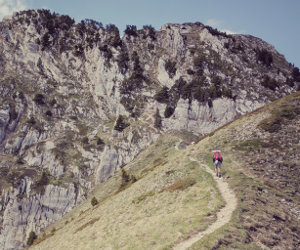

Does this trail look steep to you?
It looks steep to me! And I expect I would be walking up it slow and steady.
So, what do you think the grade is? 10 degrees? 20 degree?
When you look at the numbers, it's a bit disappointing. It's not really too impressive to think 'Hey, I just hiked a 9 degree hill for 2 miles!' but that's actually a steep trail. Really.
The Bright Angel Trail in the Grand Canyon, at its steepest, is less than 16 degree grade.
The North Kaibab Trail, over its length, averages less than 12 degree grade.
A few steepness examples:
- 5 - wheelchair ramp
- 30 - a steep ski slope
- 40 - home staircase
- 75 - ladder
- 80 - cliff face
Having hiked quite a few miles across the flats of Florida, hills of Minnesota and Wisconsin, and the steeps of the Appalachian and Rocky Mountains, I've found the grade of the trail makes a huge impact on my happiness while hiking. It's not just me - there are serious governing documents written about trail building that give great guidelines. Many of the guidelines are to prevent erosion and improve maintainability, but the experience of the visitor is also considered. A trail that is flat and straight is no better experience to a hiker than one that is steep and straight, possibly even a worse experience.


Everyone has their own 'Preferred Grade' graph like this one. When I can cruise along over easy low hills and shallow dips, I feel like I can walk all day. There is interest in finding out what is over the next rise.
I can still cover miles over challenging terrain that is a bit steeper, but my pace drops a little and my legs get tired after a few hours. Bends in the trail, tumbling creeks, varying plant life, and some higher views keep me motivated to hike on.
At some point, the trail turns strenuous. Now, my muscles are working and I need to slow my pace, take more breaks, and breathe more. My knees bother me on the downhill sections, but hiking poles help me along. The extra effort is worth it to see waterfalls, rocky outcrops, and far away landscapes from high on the side of a mountain.
When the trail is so steep I can envision a ladder working better than boots, and every downhill step jars my legs, then it is frustrating for me. It just stopped being any fun at all.
On the other hand, a flat, straight trail becomes boring quickly. You may cover ground quickly, but seeing where you're headed for hour after hour is monotonous.
From my experience, the Ice Age Trail is Easy with a few Challenging stretches. The Arizona Trail is Challenging with a couple Strenuous spots. The Appalachian Trail is Strenuous and sometimes Frustrating. The Florida Trail is Easy with some parts being Boring, especially roadwalks and levees.
Notice there are no numbers on the graph - the divisions are different for each person. Knowing what you prefer will help your hikes be more enjoyable. If a topographic map of a trail shows ups and downs with hundreds of feet of elevation change, realize that will require more effort and a slower pace. If the terrain is all forest, even the trail high points, your effort to climb up there may not reward you with any view.
The same graph can be used with a title of 'People I Meet on Trail'. You might prefer to have the trail completely to yourself and see no one for a week. Most people like to run into a few other people, but some like to have another group around at every campsite to feel safe. I like to cross paths with one or two people each day, and having others in a campsite once in awhile is fine. But, seeing people ahead and behind on the trail all day, hearing dogs and people and music at stops, and sharing a site every night with new people puts me up in the 'frustrating' area.
Knowing how much human interaction I prefer helps me determine what trail to hike, the time of year to hike it, and if I would be better off with a companion or alone.
Leave Comment
Posted: 12/27/2016
Posted: 12/27/2016
12/14/2016
Support the Smokys
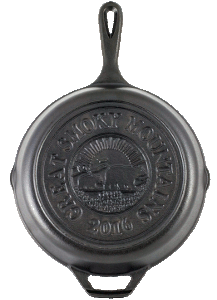

You heard about the big fire that swept through the Gatlinburg, TN area and affected the Appalachian Trail this past month, right? If you're feeling like helping out, here's a way that might sit well with you.
Lodge will donate $15 from each sale of this $30 limited-edition 10.25 inch Great Smoky Mountains 2016 skillet to the Dollywood Foundation's My People Fund, helping families affected by the devastating wildfires in the Gatlinburg, TN area.
If you're looking for some cast iron, and would like to help out some fellow Americans down on their luck, go for it.
12/13/2016
My Trail
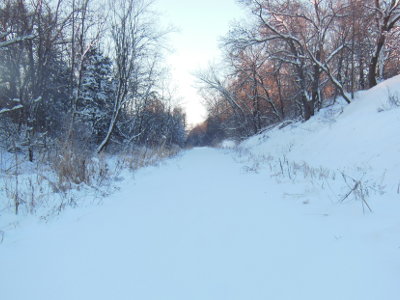
 Coldest day of winter so far. Six miles walking on the trail this morning and I didn't see anyone else. Not even a rabbit, squirrel, turkey, or deer. I guess when it's -10F it's My Trail and I don't have to share.
Coldest day of winter so far. Six miles walking on the trail this morning and I didn't see anyone else. Not even a rabbit, squirrel, turkey, or deer. I guess when it's -10F it's My Trail and I don't have to share.Five inches of fresh, fluffy snow and I got to make the first tracks through it - pretty fun. But, it was a bit cold out.
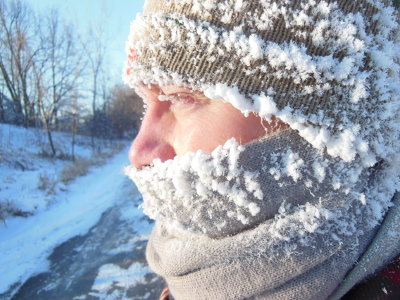
 Frost builds up everywhere when you're exhaling warm, moist air for an hour and a half. A scarf really, really helps since it traps warm air around your face and heats the air a bit before it gets sucked into your lungs.
Frost builds up everywhere when you're exhaling warm, moist air for an hour and a half. A scarf really, really helps since it traps warm air around your face and heats the air a bit before it gets sucked into your lungs.Fortunately, there was no wind today so it could have been a lot worse. I normally wear sunglasses since the snow is so bright once the sun comes up, but when it's this cold they fog up so bad I can't see at all.
Leave Comment
Posted: 12/13/2016
Posted: 12/13/2016
11/28/2016
NCT 100 Challenge
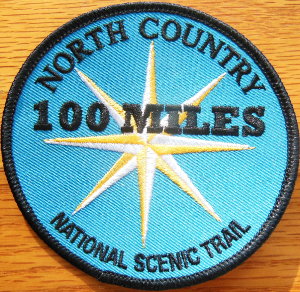

Check it out - I got my North Country '100 Miles' patch! Anyone can get this, and the accompanying certificate, by hiking any 100 miles of the North Country National Scenic Trail before January 1, 2017. So, you've got a month left to get 'er done.
You can walk the same mile of trail back and forth and back and forth and ..., or just start hiking and don't stop until you've gone at least 100 miles. That's not hard since the NCT is 4,600 miles long from the middle of North Dakota to the New York/Vermont border. I did my 100 miles on the Superior Hiking Trail, completing 85 miles with a friend on a 5-day backpacking trip and then the other 15 miles on pieces of the trail through Duluth. The Superior Hiking Trail, Border Route Trail, and Kekekabic Trail are all part of the NCT in Minnesota.
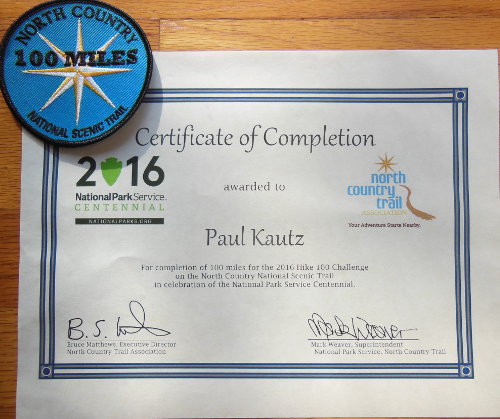

Snowshoeing, running, and walking are all legal ways to do your 100 miles. Weekend hikes in December or a longer trip after Christmas will get you through the challenge. You can read more details at this NCT page.
You might not have time to do all 100 miles at this point, but if you've already hiked some, push it to finish it! A couple weekends could do it.
You might even win some very cool gear - no, wait, I'm winning that!
#Hike100NCT
Leave Comment
Posted: 11/28/2016
Posted: 11/28/2016
11/27/2016
Frosty Walk
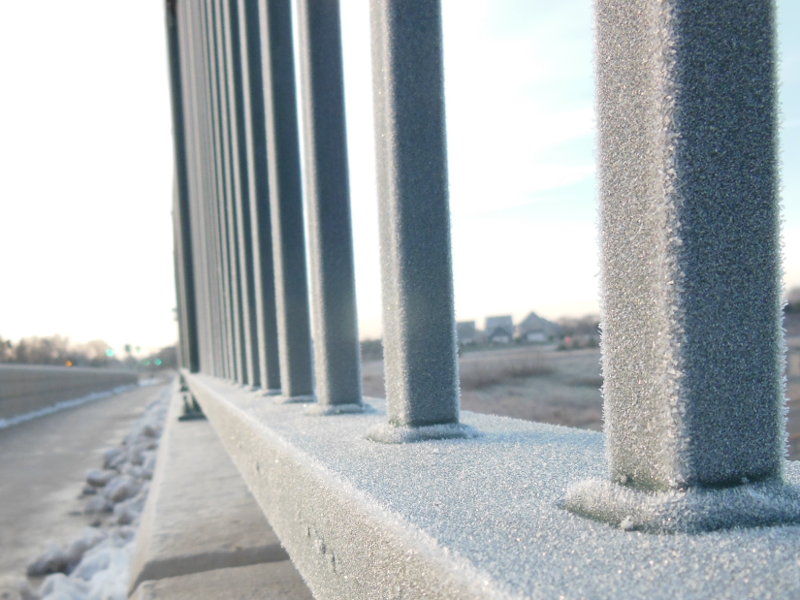

Bundling up a bit more every morning as the temps slowly fall and the frost gets thicker. With the clear, crisp, beautiful days, it all melts away fast but comes back each morning.
It's much more quiet on the walking trails these days as the summer runners and bikers are calling it quits for the winter. That's fine - more opportunity to visit with all the critters along the way that haven't migrated or set up their winter lair to wait out the cold months.
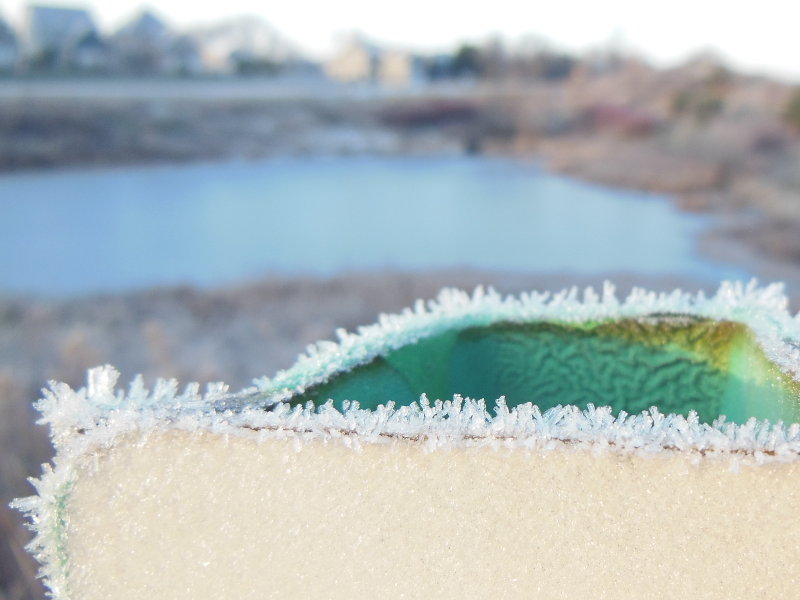
This stretch between Thanksgiving and Christmas is a very important time to keep up with my morning walks - try to keep the winter fat from building up and keep the blood from freezing in the veins. :-) Actually, I'm really just hoping for some big snow soon so we can do some cross country skiing this winter. It's historically a 50/50 chance of having a white winter here, so we'll see.
10/27/2016
Gaiter Protection
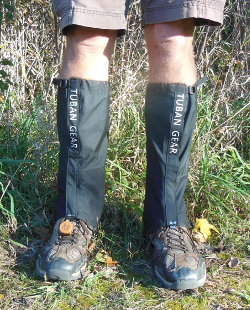

Not protection FROM 'gators', but protection BY 'gaiters'.
#TubanHikingGaitersSnowGaiters
One reason I like backpacking up in the mountains above timberline is because I can see forever. Not just the wonderful scenery, but the terrain around me, too. No little animals or snakes rustling in the brush right beside me, no prickly thorns and weeds scratching me, and no roots tripping me while I hike along. Unfortunately, those high mountain hikes are relatively rare since I'm a flatlander and do most of my hiking through forest, grasslands, and prairies. These are beautiful, but there's a much higher probability of light injury to my lower legs.
A good way to keep lower legs safe, is to wear a light pair of gaiters. Ankle-high gaiters keep debris out of your shoes as well as a bit of rain, but calf-high gaiters do all that plus provide protection to shins and much more water resistance.
Gaiters are wonderful to keep snow off my pants and out of my boots. Staying dry in cold weather is as important as staying warm. They also help with rain by diverting drips off the shoe instead of letting it soak into the sock and into the shoe. Besides snow and rain, gaiters also stop sand, gravel, twigs, and other trail debris from working its way down to my feet to cause irritation, blisters, and a grumpy mood. Plus, knees down is where most of the trail dirt and grime are accumulated so gaiters help keep me and my clothes clean on the trail.
Gaiters also provide lower leg protection, specifically against shin scrapes and scratches. While hiking through an old train tunnel doing research for my next book, I hit my leg on a big rock. I was moving my feet slowly and taking my time since I had no flashlight - well, I had one but I was too lazy to get it out for this short tunnel. Oops. No real injury as more than a foot of skin on my shin got peeled off, but it bled and stung for an hour or so and it's just now pretty much healed. A sturdy gaiter would not have prevented me from being stupid about the light, but it would have prevented almost all the damage from that kind of injury.
More common than running into rocks is getting scratched by vegetation. Hiking the 800-mile Arizona Trail, I had my fair share of pokes, scratches, scrapes, and cuts. I was fortunate to not get any cactus injuries, but every plant in the desert is designed to injure whatever comes close to it. One of my water bags even got punctured. Gaiters are perfect protection while hiking in this territory or any place where the trail is narrow or if you have to bushwhack cross country.
The plants and grasses, even those that don't bite, are still irritating in the morning. Hiking the Ice Age Trail, the first couple hours most mornings got my lower legs and shoes soaked just because of the heavy dew and walking through the prairie grass, brush, or whatever was growing along the narrow, less used trail. Gaiters, worn just those first couple hours each day, would have made life much more pleasant.
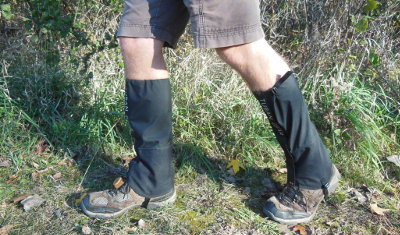

I've owned a pair of gaiters since 1984 - yes, that long! But, I just got a new pair of Tuban Gaiters for free to try and review. They make my old pair (which still work fine) look and feel ancient.
My new gaiters weigh just 2.5 ounces each versus the old 3.5 oz. each so it's easy to forget they are on. They have a strong synthetic instep strap instead of a lace strap so I expect that to withstand abuse from the trail pretty well. A front velcro-type opening replaces my old rear zipper so they are much easier to put on and off. And, the top cinch is a strap and buckle rather than a lace. All in all, a huge improvement in design over a short 30 years. :-)
These gaiters are also a good Leave No Trace piece of gear. The synthetic fabric is so tightly woven that burrs, seeds, and other stickers don't cling to it for transportation. You don't wind up being a vehicle for invasive plants to have their seeds dispersed by hitching a ride on your pants or socks, just to be plucked off and thrown to the side to grow at your next rest stop. Also, with the protection from gaiters, you are more prone to stay on the trail instead of straying to avoid any small nuisance in the path.
If you're interested in checking out my gaiters, hike to Amazon and take a look. If you buy a pair, use this code to save 50% ( CRDTRIFX ) They come in black, blue, or orange. This time of year, any extra orange is helpful.
The largest part of my calf is 17 inches around, and 16 inches around just below the knee where the gaiter top rests. The size Large fits fine, but if your legs are larger, go for the size XL. Measure up 18 inches from the floor when standing to find where the gaiter top will be on your leg.
Hike On
Leave Comment
Posted: 10/27/2016
Posted: 10/27/2016
Older Posts Newer Posts
Find more Hiking Resources at www.HikingDude.com


Follow Me
Recent Comments